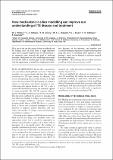Files in this item
How mechanistic in silico modelling can improve our understanding of TB disease and treatment
Item metadata
| dc.contributor.author | Pitcher, Michael John | |
| dc.contributor.author | Dobson, Simon Andrew | |
| dc.contributor.author | Kelsey, Tom | |
| dc.contributor.author | Chaplain, Mark Andrew Joseph | |
| dc.contributor.author | Sloan, Derek James | |
| dc.contributor.author | Gillespie, Stephen Henry | |
| dc.contributor.author | Bowness, Ruth | |
| dc.date.accessioned | 2020-11-11T15:30:07Z | |
| dc.date.available | 2020-11-11T15:30:07Z | |
| dc.date.issued | 2020-11-01 | |
| dc.identifier | 269148390 | |
| dc.identifier | c847b1ec-88e1-4f6a-96c3-cfabc7b7c89c | |
| dc.identifier | 85096029555 | |
| dc.identifier | 000601098500003 | |
| dc.identifier.citation | Pitcher , M J , Dobson , S A , Kelsey , T , Chaplain , M A J , Sloan , D J , Gillespie , S H & Bowness , R 2020 , ' How mechanistic in silico modelling can improve our understanding of TB disease and treatment ' , International Journal of Tuberculosis and Lung Disease , vol. 24 , no. 11 , pp. 1145-1150 . https://doi.org/10.5588/ijtld.20.0107 | en |
| dc.identifier.issn | 1027-3719 | |
| dc.identifier.other | ORCID: /0000-0002-8091-1458/work/83481726 | |
| dc.identifier.other | ORCID: /0000-0002-4090-5168/work/83481808 | |
| dc.identifier.other | ORCID: /0000-0001-6537-7712/work/83481823 | |
| dc.identifier.other | ORCID: /0000-0001-5727-2160/work/83481901 | |
| dc.identifier.other | ORCID: /0000-0001-9633-2103/work/83482096 | |
| dc.identifier.other | ORCID: /0000-0002-7888-5449/work/83481952 | |
| dc.identifier.uri | https://hdl.handle.net/10023/20951 | |
| dc.description | Funding: Medical Research Council [grant number MR/P014704/1], The Academy of Medical Sciences (AMS), the Wellcome Trust, the Government Department of Business, Energy and Industrial Strategy (BEIS), the British Heart Foundation and the Global Challenges Research Fund (GCRF) [grant number SBF003\1052] and the PreDiCT-TB consortium (IMI Joint undertaking grant agreement number 115337, resources of which are composed of financial contribution from the European Union’s Seventh Framework Programme (FP7/2007-2013) and EFPIA companies’ in kind contribution. | en |
| dc.description.abstract | TB is one of the top 10 causes of death worldwide and the leading cause of death from a single infectious agent. Decreasing the length of time for TB treatment is an important step towards the goal of reducing mortality. Mechanistic in silico modelling can provide us with the tools to explore gaps in our knowledge, with the opportunity to model the complicated within-host dynamics of the infection, and simulate new treatment strategies. Significant insight has been gained using this form of modelling when applied to other diseases – much can be learned in infection research from these advances. | |
| dc.format.extent | 6 | |
| dc.format.extent | 327791 | |
| dc.language.iso | eng | |
| dc.relation.ispartof | International Journal of Tuberculosis and Lung Disease | en |
| dc.subject | TB modelling | en |
| dc.subject | Disease models | en |
| dc.subject | Statistical modelling | en |
| dc.subject | Within-host mechanistic model | en |
| dc.subject | QA75 Electronic computers. Computer science | en |
| dc.subject | RA0421 Public health. Hygiene. Preventive Medicine | en |
| dc.subject | RC Internal medicine | en |
| dc.subject | NDAS | en |
| dc.subject | SDG 3 - Good Health and Well-being | en |
| dc.subject.lcc | QA75 | en |
| dc.subject.lcc | RA0421 | en |
| dc.subject.lcc | RC | en |
| dc.title | How mechanistic in silico modelling can improve our understanding of TB disease and treatment | en |
| dc.type | Journal article | en |
| dc.contributor.sponsor | Medical Research Council | en |
| dc.contributor.sponsor | Academy of Medical Sciences | en |
| dc.contributor.sponsor | European Commission | en |
| dc.contributor.institution | University of St Andrews. Sir James Mackenzie Institute for Early Diagnosis | en |
| dc.contributor.institution | University of St Andrews. School of Computer Science | en |
| dc.contributor.institution | University of St Andrews. Centre for Interdisciplinary Research in Computational Algebra | en |
| dc.contributor.institution | University of St Andrews. School of Mathematics and Statistics | en |
| dc.contributor.institution | University of St Andrews. Applied Mathematics | en |
| dc.contributor.institution | University of St Andrews. Infection and Global Health Division | en |
| dc.contributor.institution | University of St Andrews. School of Medicine | en |
| dc.contributor.institution | University of St Andrews. Centre for Biophotonics | en |
| dc.contributor.institution | University of St Andrews. Global Health Implementation Group | en |
| dc.contributor.institution | University of St Andrews. Gillespie Group | en |
| dc.contributor.institution | University of St Andrews. Infection Group | en |
| dc.contributor.institution | University of St Andrews. Biomedical Sciences Research Complex | en |
| dc.identifier.doi | 10.5588/ijtld.20.0107 | |
| dc.description.status | Peer reviewed | en |
| dc.identifier.grantnumber | MR/P014704/1 | en |
| dc.identifier.grantnumber | SBF003\1052 | en |
| dc.identifier.grantnumber | en |
This item appears in the following Collection(s)
Items in the St Andrews Research Repository are protected by copyright, with all rights reserved, unless otherwise indicated.

